
After that great train ride on the Potomac Eagle Scenic Railroad, Chris Parker's and my next destination was the Horseshoe Curve National Historical Landmark just west of Altoona, Pennsylvania. We drove north on West Virginia 28 back towards Cumberland.
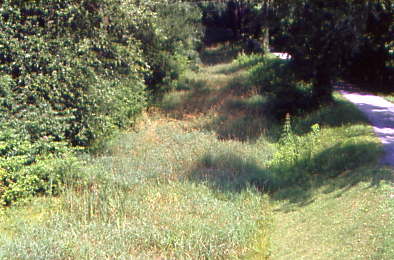
We crossed the Chesapeake and Ohio canal on our approach to Cumberland. Our next stop was less than a mile north at the CSX Cumberland Locomotive Maintenance Facility. All our photographs were taken through the fence as we never trespass.
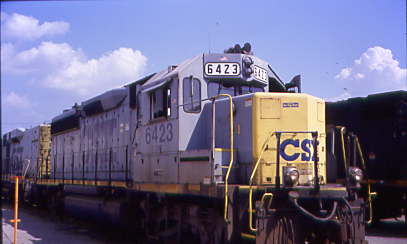
CSXT GP40-2 6423, ex. CSXT 6184, nee Baltimore and Ohio 4285 built by Electro-Motive Division in 1978.
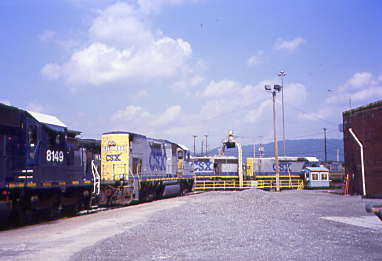
CSXT SD40-2 8149, ex. Seaboard System 8149, nee Louisville and Nashville 8149 built by Electro-Motive Division in 1981, and CSXT GP15 1523, nee Chesapeake and Ohio 1523 built by Electro-Motive Division in 1982.
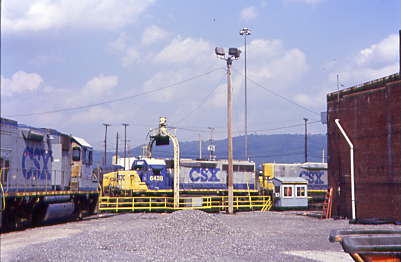
CSX GP40-2 6438, exx. CSXT 6322, nee Baltimore and Ohio 4424 built by Electro-Motive Division in 1981, rode the turntable this afternoon.
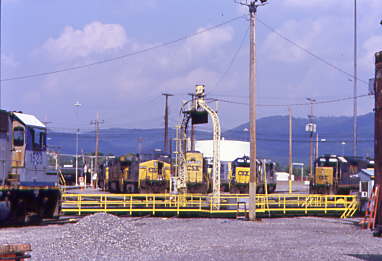
CSXT GP15 1523 overlooked the turntable.
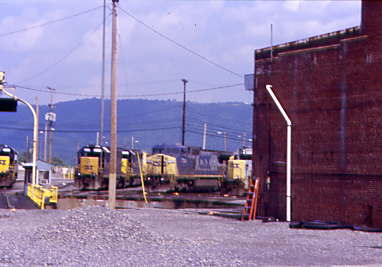
CSXT C44-8W 7704, built by General Electric in 1991, kept on eye on its mates.

After seeing all this motive power, we drove US 220 north to Bedford, which turned into Interstate 99, our route to Altoona. As we neared Duncanville, we crossed over railroad tracks and spotted some locomotives. Four miles of back- tracking took us right to them.
The Everett Railroad Company 7/15/2006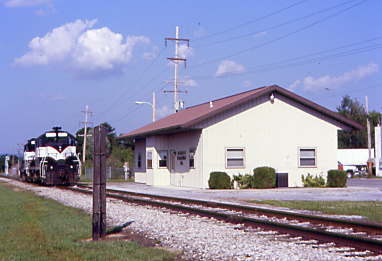
In August 1984, at Claysburg, Pennsylvania, Everett Railroad GE 80-Ton 4 made a delivery of bauxite ore to the General Refractories Company. That train marked the rebirth of a railroad that had been dormant since 1982. In those two years, the railroad had been abandoned, sold, and moved from its home in Everett, PA, where it had served its namesake community since 1954.
The new Everett Railroad was based in Claysburg, on seven miles of railroad between Brookes Mill and Sproul that Conrail had deemed excess. Two customers, Champion Homes and General Refractories wished to see rail service resumed. Working with those companies, the Everett restored the former-Conrail trackage and began operations on an as-needed basis. In 1985, the Everett Railroad leased the nearby Morrisons Cove Railroad, a seven-mile line which served the fertile "Cove" region of Blair County including the communities of Roaring Spring, Martinsburg, and Curryville. With this expansion, the Everett Railroad became a key link in local agriculture and dairy production, serving three feed mills as well as a major paper converter. Increased traffic led to the purchase of two EMD SW9s from Conrail: 8933 and 8990.
Also, during that time, the railroad hauled its first tourists since the early 1970s as the National Railway Historical Society operated several excursions over the railroad. Expansion occurred again in 1995 with the incorporation of a sister company, the Hollidaysburg & Roaring Spring Railroad which acquired ten miles of Conrail's "Cove Secondary" track. This purchase tied together the Everett Railroad and Morrisons Cove Railroad operations and created what is today a twenty-three-mile rail network. Now, the railroad typically operates scheduled trains three days per week, with special service available on request. Interchange for the Everett Railroad is with Norfolk Southern at Hollidaysburg.
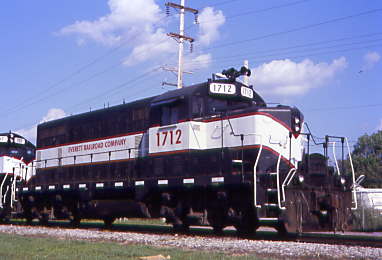
Everett Railroad GP16 1712, ex. R.J. Corman 1712, exx. CSX Transportation 1712, exxx. Seaboard System 1712, ex. Clinchfield Railroad 4612, nee Clinchfield 911, built by Electro-Motive Division in 1950.
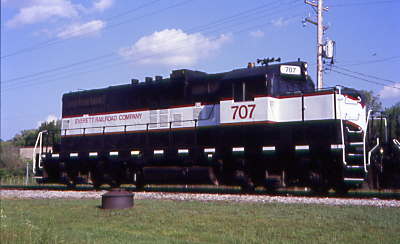
Everett Railroad GP10 707, ex. Ohio Central System 707, exx. Qwest Communications 707, exxx. MidSouth 1065, exxxx. Gulf and Mississippi 8148, exxxxx. Illinois Central Gulf 8418, nee Illinois Central GP9 9148 built by Electro- Motive Division in 1956.
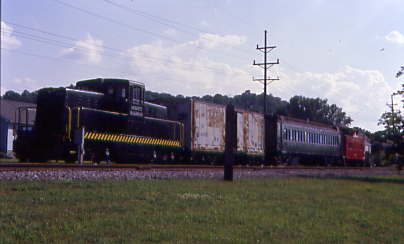
Everett Railroad display train.

Everett Railroad 80 ton switcher 4, nee United States Army 7893 built by General Electric in 1943. We drove north, stopping at a Sheetz petrol station then continued on to Horseshoe Curve for my our first visit to this historic location.
Horseshoe Curve National Historical LandmarkIn 1834, the Commonwealth of Pennsylvania built the Allegheny Portage Railroad across the Allegheny Mountains to connect Philadelphia and Pittsburgh, as part of the Main Line of Public Works. The Portage Railroad was a series of canals and inclined planes and remained in use until the mid-19th century. The Pennsylvania Railroad was incorporated in 1847 to build a railroad from Harrisburg to Pittsburgh, replacing the cumbersome Portage Railroad. Using surveys completed in 1842, the state's engineers recommended an 84-mile route west from Lewistown that followed the ridges with a maximum grade of 0.852 percent. But the Chief Engineer for the Pennsylvania Railroad, John Edgar Thomson, chose a route on lower, flatter terrain along the Juniata River and accepted a steeper grade west of Altoona. The valley west of Altoona was split into two ravines by a mountain; surveys had already found a route with an acceptable grade east from Gallitzin to the south side of the valley, and the proposed Horseshoe Curve would allow the same grade to continue to Altoona.
Work on Horseshoe Curve began in 1850 and was done without heavy equipment, only men "with picks and shovels, horses and drags". Engineers built an earth fill over the first ravine encountered while ascending, formed by Kittanning Run, cut the point of the mountain between the ravines, and filled in the second ravine, formed by Glenwhite Run. The 31.1-mile line between Altoona and Johnstown, including Horseshoe Curve, opened on February 15, 1854. The total cost was $2,495,000 or $80,225 per mile.
In 1879, the remaining part of the mountain inside the curve was levelled to allow the construction of a park and observation area—the first built for viewing trains. As demand for train travel increased, a third track was added to the curve in 1898 and a fourth was added two years later. From around the 1860's to just before World War II, passengers could ride to the PRR's Kittanning Point station near the curve. Two branch railroads connected to the main line at Horseshoe Curve in the early 20th century; the Kittanning Run Railroad and the railroad owned by the Glen White Coal and Lumber Company followed their respective creeks to nearby coal mines. The Pennsylvania Railroad delivered empty hopper cars to the Kittanning Point station which the two railroads returned loaded with coal.[20] In the early 1900s, locomotives could take on fuel and water at a coal trestle on a spur track across from the station.
A reservoir was built at the apex of the Horseshoe Curve in 1887 for Altoona; a second reservoir, below the first, was finished in 1896. A third reservoir, Lake Altoona, was completed by 1913. A macadam road to the curve was opened in 1932 allowing access for visitors, and a gift shop was built in 1940.
Horseshoe Curve is five miles west of Altoona, in Logan Township, Blair County. It sits at railroad milepost 242 on the Pittsburgh Line, which is the Norfolk Southern Railway Pittsburgh Division main line between Pittsburgh and Harrisburg. Horseshoe Curve bends around a dam and lake, the highest of three Altoona Water Authority reservoirs that supply water from the valley to the city. It spans two ravines formed by creeks: Kittanning Run, on the north side of the valley and Glenwhite Run, on the south. The Blair County Veterans Memorial Highway (SR 4008) follows the valley west from Altoona and tunnels under the curve.
Westbound trains climb a maximum grade of 1.85 percent for 12 miles from Altoona to Gallitzin. Just west of the Gallitzin Tunnels, trains pass the summit of the Allegheny Mountains, then descend for 25 miles to Johnstown on a grade of 1.1 percent or less. The overall grade of the curve was listed by the Pennsylvania Railroad as 1.45 percent; it is listed as 1.34 percent by Norfolk Southern. The curve is 2,375 feet long and about 1,300 feet across at its widest. For every 100 feet, the tracks at the Horseshoe Curve bend 9 degrees 15 arc minutes, with the entire curve totaling 220 degrees.
During World War II, the PRR carried troops and materiel for the Allied war effort and the curve was under armed guard. The military intelligence arm of Nazi Germany, the Abwehr, plotted to sabotage important industrial assets in the United States in a project code-named Operation Pastorius. In June 1942, four men were brought by submarine and landed on Long Island, planning to destroy such sites as the curve, Hell Gate Bridge, Alcoa aluminum factories and locks on the Ohio River. The would-be saboteurs were quickly apprehended by the Federal Bureau of Investigation after one, George John Dasch, turned himself in. All but Dasch and one other would-be saboteur were executed as spies and saboteurs.
Train count peaked in the 1940;s with over fifty passenger trains per day, along with many freight and military trains. Demand for train travel dropped greatly after World War II, as highway and air travel became popular. During the 1954 celebration of the centennial of the opening of Horseshoe Curve, a night photo was arranged by Sylvania Electric Products using 6,000 flashbulbs and 31 miles of wiring to illuminate the area. The event also commemorated the 75th anniversary of the incandescent light bulb.
Pennsylvania steam locomotive 1361 was placed at the park inside the Horseshoe Curve on June 8, 1957. It is one of 425 K4s-class engines: the principal passenger locomotives on the Pennsylvania Railroad that regularly plied the curve. The Horseshoe Curve was listed on the National Register of Historic Places and was designated a National Historic Landmark on November 13, 1966. The operation of the observation park was transferred to the city of Altoona the same year. The Pennsylvania Railroad was combined with the New York Central Railroad in 1968, creating Penn Central, which went bankrupt in 1970 and was taken over by the federal government in 1976, as part of the merger that created Conrail.
The second track from the inside at the Horseshoe Curve was removed by Conrail in 1981. The K4 1361 was removed from the curve for a restoration to working order in September 1985 and was replaced with the ex-Conrail EMD GP9 diesel- electric locomotive 7048 that was repainted into a Pennsylvania Railroad scheme. Starting in June 1990, the park at the Horseshoe Curve underwent a $5.8 million renovation funded by the Pennsylvania Department of Transportation and by the National Park Service through its "America's Industrial Heritage Project". The renovations were completed in April 1992 with the dedication of a new visitor center.
In 1999, Conrail was divided between CSX Transportation and Norfolk Southern, with the Horseshoe Curve being acquired by the latter. The Horseshoe Curve was lit up again with fireworks and rail-borne searchlights during its sesquicentennial in 2004 in homage to the 1954 celebrations and was designated a National Historic Civil Engineering Landmark by the American Society of Civil Engineers in 2004.

As I walked up the stairs, our first train around the curve was Norfolk Southern 8356 East.

Just as I neared the top, a westbound was going around and had these helpers.
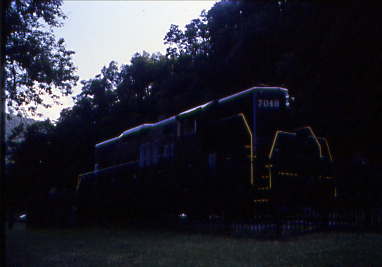
Conrail GP 7048, ex. Penn Central 7048, nee Pennsylvania Railroad GP9 7048 built by Electro-Motive Division in 1955, on display. It was placed here in 1985 and restored to its original Pennsylvania Railroad paint scheme.

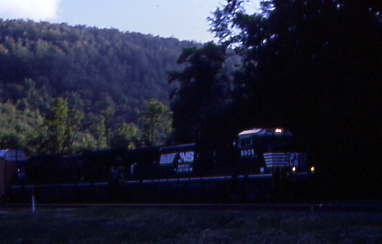
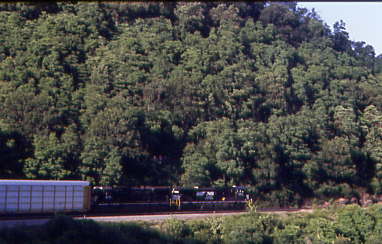
Next, Norfolk Southern 9905 East came around the curve on Track 2.
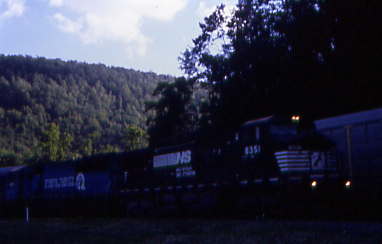
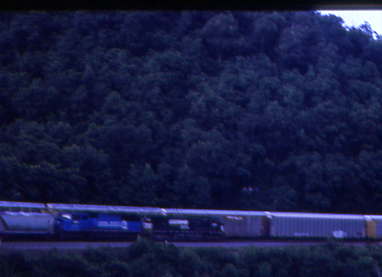
Then on Track 1 was Norfolk Southern 8351 East. With both us hungry, we walked downstairs but knew we would be back here tomorrow afternoon much earlier and in better light. We drove to Altoona, looking for a restaurant and found the Kings Family Restaurant where we had an excellent meal. After dinner on the way out of town, we stopped at the Railroaders Memorial Museum.
Railroaders Memorial MuseumFounded in 1980, the Railroaders Memorial Museum was established by Altoona leaders who sought to preserve the accomplishments and legacy of railroaders who founded the city in 1846 and the industry that turned Altoona into a renowned railroad city with over three miles of shops, foundries, yards and Test Plant. The railroad was the heart of the city and its center; businesses, neighborhoods, and life were synchronized to the schedules of trains and work shifts. As the shops and yards expanded, so did the city. A need for a workforce meant an opportunity for immigrants from England, Ireland, Germany, Italy and other minorities to create a melting pot of culture in Railroad City. Altoona supported a network of 26,000 miles with freight cars, passenger cars and over 17,000 steam locomotives constructed by Altoona workers. After the steam era, Altoona transitioned its industrial purpose. As a result job reductions and reassignments in the workforce occurred when the steam era ended in 1957.
The commonwealth of Pennsylvania established a commission to select a home for an official state railroad museum, Altoona was considered; however Strasburg was selected. For local leaders and rail enthusiasts (members of the Horseshoe Curve Chapter of the National Railway Historical Society) it was the decision that ignited a movement to create a railroad museum for Altoona. Grassroots efforts lead to the creation of Railroaders Memorial Museum which opened in 1980. The collection was humble, being formed of collectables of local residents. Privately funded, and privately sanctioned; the Railroaders Memorial Museum obtained its collection organically over the succeeding 43 years. The founders of the museum saw the apex of the Pennsylvania Railroad in the 1930's and 1940's to the fall of the industry in 1968 with Penn Central to the rebirth with Consolidated Rail Corporation. They saw the railroad change in a course of a generation and with it the City. To them, the museum was a beacon of hope to celebrate the legacy of railroaders past but also inspire railroaders of today. Showcasing what ordinary people did, how they overcame physical and social barriers to create the backbone of the world’s largest railroad corporation.
The organization outgrew its humble 1980 built exhibit hall and in 1998 opened the restored PRR Master Mechanic's Office Building on the adjacent land (site of the first PRR shops in Altoona). Built in 1882, this structure was the reflection of the railroad in Altoona. It started as a simple office and stores building for the Altoona Machine Shops, eventually expanded both in length and additional floors, it housed the first test department, railroad police department, engineering, Middle Division headquarters, dispatching and the C&S department. Today, this building serves a purpose for exhibitions, programs, collections and museum administrative offices. When opened in 1998, it was the only interactive railroad museum in the country and has been a source of inspiration for newer museums.
In the early 1990's, the museum acquired the Horseshoe Curve National Historic Landmark from the City of Altoona and Conrail to operate the visitor's center and observation park, this was after a partnership with the National Park Service and Commonwealth of Pennsylvania renovated the site into what it is today. The organization acquired 1361 a Pennsylvania Railroad K4s class pacific locomotive in 1987 from Conrail and returned to its brief operation. This opportunity in the 1980's has established a longing by local residents and enthusiasts for its return to operation. This locomotive has been named "The Spirit of Altoona". The K4 led to the need for the museum to develop a plan to construct a facility to house and maintain the locomotive and the museum’s rolling stock.

I walked in through the gate and started to explore.

Pennsylvania Railroad caboose 477577 built by the railroad in 1929.
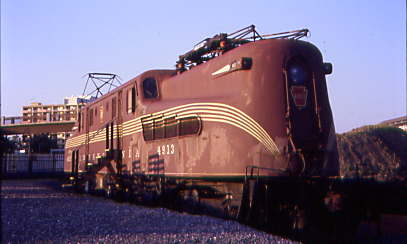
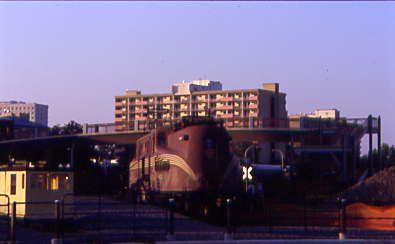
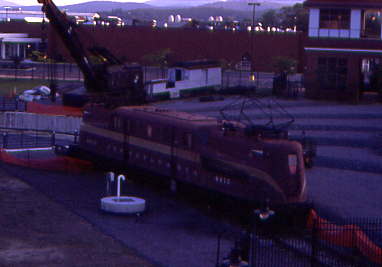
Pennsylvania Railroad GG-1 4913 built by the railroad in 1942. It was one of 139 such locomotives built for the PRR's 11,000 volt electrified New York, Washington and Harrisburg routes, the busiest lines in the United States. 4913 saw many miles pulling the Pennsy's famous "Congressional" passenger train. The GG-1 type, first built in 1934, could handle 20 passenger cars at speeds up to 100 mph and is one of the most successful electric locomotive designs in the world. Some GG-1’s worked in first-line assignments for nearly 50 years. No. 4913 was retired in 1980 and is one of only five GG-1's to be originally painted in PRR Tuscan Red with five gold stripes.
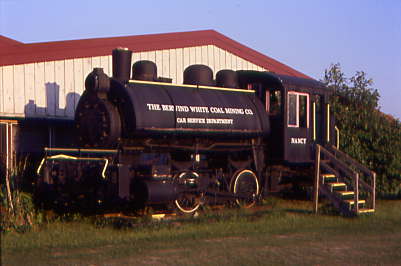
Berwind-White Coal Mining Company 0-4-0ST "Nancy", nee C.M. Berwind Mines "Nancy" built by Vulcan Iron Works in 1918. It operated until the early 1960's, making it the last steamer to operate in Blair County. This 0-4-0 type never had a tender, being carried in a saddle shaped tank that sits atop the boiler. Coal was carried in a bunker at the rar of the cab.
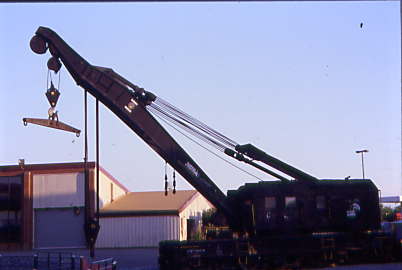
Conrail 250 ton crane 45215, nee New York Central X-16, built by Industrial Brownhoist, year unknown.
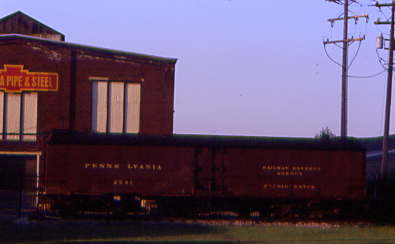
Pennsylvania Railroad Class R50B express refrigerator car 2561 built by the railroad in 1929. It was equipped with steam-heat lines, signal lines and passenger-car-type brakes for use in passenger trains and is the only known survivor of its class.
Chris and I checked both of the walkway bridges over the tracks and although there were no trains, it gave us ideas for future visits. We then drove north on Interstate 22 to Tyrone and turned right onto Pennsylvania 453 to US 22, which took us to Huntington.

Here we spent the night at the Huntington Motor Inn and waited for our next two new rail experiences on the East Broad Top Railroad and Rockhill Trolley Museum.
| RETURN TO THE MAIN PAGE |